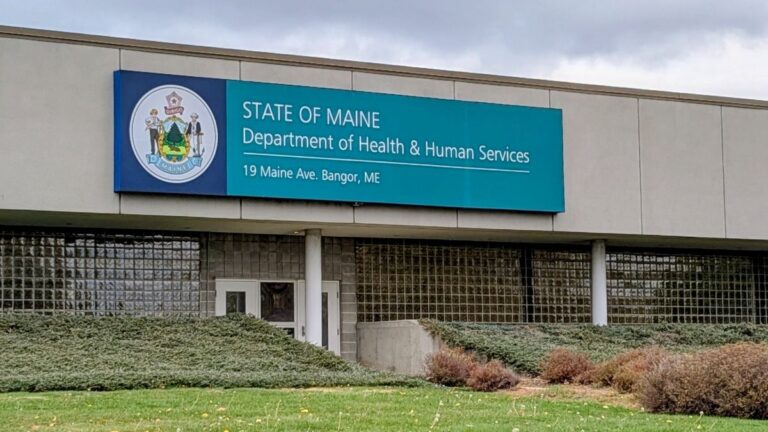Seven generations of George Brace’s family have lived in their 1790 federal style house on Campbell Hill in Cherryfield. Perched mere steps from a rolling, two-lane road, a stone retaining wall is all that separates the house and a row of others from the buzzing traffic on Route 1, about a quarter-mile from the intersection with Route 193 in the heart of the town’s historic district.
But in the coming years, the new I-395 extension two counties away is expected to push more traffic into Cherryfield and the other communities dotting Route 1, changing the character of the sleepy, rural communities.
“What am I going to do about it? Nothing. Regardless of whether I have concerns or not. I don’t see where I can change anything, so there’s no sense investing emotional energy in it,” Brace said.
The six-mile I-395 connector is being constructed between Brewer and Eddington on Route 9, also known as the Airline Road. The total cost is approximately $124 million, including the Wilson Street bridge and related work. The project is expected to be completed in 2025.
According to the Maine Department of Transportation, the I-395/Route 9 connector, commonly known as the bypass, will provide a regional solution to problems of transportation connectivity, safety and mobility.
But since it was conceived several years ago, the project has been clouded by criticism and controversy, even from Washington County, where its closest point is more than 30 miles from the bypass.
Some officials and residents say the bypass will direct traffic not bound for Bar Harbor and Acadia over to Route 9, then ultimately to Route 193 into Cherryfield 19 miles away, where it intersects with Route 1.
“It’s going to increase the number of vehicles. It’s also going to increase the speed of vehicles. And it will bring a lot more traffic into downtown Cherryfield, which has some safety issues with sightlines at the major intersection with 193 and Route 1,” said Crystal Hitchings, the community promotion director for the Sunrise County Economic Council in Machias.
In response, DOT believes the new extension will help solve transportation problems, not create them. “We do not expect substantial traffic impacts in Cherryfield,” said DOT spokesman Paul Merrill.
The extension is the most high-profile project underway in the region, but far from the only one.
After decades of debate and inaction, the wheels of local, state and federal government seem to be bringing solutions Down East, but not without new concerns.
The first glimmer of progress came in March when the Maine DOT unveiled a $3.94 billion statewide transportation overhaul that includes an estimated $187,419,000 for Washington County, according to Merrill, the agency’s director of communications.
The Three-Year Work Plan includes 109 projects throughout the county, including a 68-mile repaving project on Route 1; improvements at Machias Valley Airport, moving it a small step toward attracting a commercial airline; and a swath of road, culvert and bridge projects that will be completed over the next three years.
With the contentious Highway Fund budget finally signed into law Thursday by Gov. Janet Mills, projects are moving forward.
“Keep in mind that many of our projects that are characterized as highway projects also take into consideration improvements that will benefit all users of our transportation system — wider shoulders or other safety improvements, for example,” Merrill said.
Some municipalities, such as Calais and Danforth, hope to take advantage of another state-run program, the Village Partnership Initiative, launched last year to partner with municipalities and leverage money to revamp downtown and village areas. It includes repairing crumbling sidewalks and adding lighting to improve safety for pedestrians, cyclists and others using “microtransit” like skateboards.
Although seemingly small measures, the improvements could have a big impact. The US DOT Bureau of Statistics reports that In Washington County, 49 percent of all trips are five miles or less; 18 percent are one mile or less; 19 percent are one to three miles; 12 percent three to five miles. Jean Sideris, executive director of the Bicycle Coalition of Maine, said the data means the state’s investments in biking, walking, microtransit and other short-distance transportation options could serve half of all trips in Washington County.
Most of the time, Delia Mae Farris, a 76-year-old Cutler native, falls into that category. The proud granddaughter of a lighthouse keeper spends most of her time “catching rides” to nearby libraries to research and record her stories.
Without a car, Farris said bumming rides with friends — and sometimes strangers — is the only way she gets where she needs to go.

“If anybody is brave enough to try it, I recommend it for a while. I really do,” said Farris, standing outside the Machias farmers market last Friday, waiting for a ride.
Pseudo-Uber systems like Farris’ are not a viable solution, said Hitchings. Neither, she added, is the county’s single Lyft car driver who started offering on-demand car service last week, but only some nights and weekends, with fares that are out of reach for most.
Hitchings is contracted by the state to design a countywide blueprint for transportation improvements funded under one of its community-based initiatives.
She said her first task will be working on a feasibility study for a publicly owned or partially public owned Uber type of on-demand service like those being piloted in some other communities, including Portland.
“It might work better in places like Eastport, Lubec, Machias and Calais that are more consolidated,” Hitchings said.
Washington County Commissioner Chris Gardner has argued that boosting the county’s population density will be the answer to many of its transportation woes.
One way to do that, he believes, is by connecting businesses to the port in Eastport. Although ambitious, Gardner is pushing for rail connectivity to be re-established Down East, recommissioning long-defunct rails to bring trains to Eastport, which he said would boost the economy countywide.
“I realize tracks are hard to pick up and move six feet to the left, but that’s the point. Our rail system in Maine was designed for the mills. Now I think it should be designed for the ports,” Gardner said.
But Calais City Manager Mike Ellis wants the defunct rails that run through the Moosehorn Refuge ripped up to allow expansion of the Down East Sunrise Trail from Ellsworth nearly to Calais. According to Ellis, the off-road trail would literally open a new avenue for microtransit, ATV riders and others riding the trail for work, medical appointments, shopping or recreation, and would generate economic activity for Calais.
In neighboring Eastport to the west, former Airport manager Steve Trieber still hopes the tortured effort to bring commercial passenger airline service to the region can be revived. Trieber and others spent 13 years growing the former modest landing strip into a fully equipped airport with a fuel station, small terminal and 4,000-foot runway that could have accommodated a smaller airline, such as Cape Air, which was ready to commit. But a crucial federal funding grant, lost late in the deal, has stalled plans for now.
With the disappointment an all-too-familiar story in a county that has succeeded only in fits and starts, making sure the DOT meets its planning goals is critical, said Sideris, who was part of the team that spent a year helping the state draft its first Active Transportation Plan, addressing the needs of pedestrians, cyclists, and others who can’t, or prefer not to, use vehicles or public transit.
“There’s not a lot of deadlines in there, but not a lot of milestones to measure progress,” Sideris said. “It’s a really good first step but there’s a long way to go to make sure the plan doesn’t just sit on a shelf.”
This story has been updated to include a response from the DOT.







